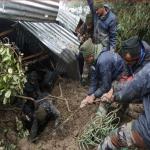ATREE News

Unseasonal rain can cause yellow crazy ant attacks in Karnataka
Invasive species of yellow crazy ants reportedly exploded all over Karanthamalai forest, Tamil Nadu. Entomologists from ATREE say warmer climates and increasing temperatures are responsible for the population explosion among yellow crazy ants.
Villagers from the area left their ant-infested homes and chased their cattle away from these tiny insects, which attack by spraying formic acid in the eyes. "Simultaneous hot, humid and wet conditions and increased productivity of the landscape due to summer showers might have favoured the ants' metabolic activities thus enabling faster reproduction, population growth and spreading," - Priyadarshan Dharmarajan.

ஈடிவி பாரத் செய்தி எதிரொலி.. விநோத எறும்புகள் குறித்து விஞ்ஞானிகள் ஆய்வு
திண்டுக்கல் மாவட்டம், நத்தம் அருகே உள்ள கரந்தமலை வனப்பகுதியில் பல 100 சதுர கிலோமீட்டர் பரப்பளவு கொண்ட மலைப்பகுதி. இந்த மலைப்பகுதியை சுற்றி பண்ணக்காடு, உலுப்பகுடி, வேலாயுதம்பட்டி, குட்டூர், குட்டுப்பட்டி, சேர்வீடு, ஆத்திப்பட்டி உள்ளிட்ட பல்வேறு மலை கிராமங்கள் உள்ளன. இந்த மலைப்பகுதியில் நடுவே சில ஆண்டுகளுக்கு முன்னர் புதிய வகை விநோத எறும்புகள் பரவியிருந்தது.

Environmentalist Who Rejuvenated A Vadodara Stream Now Cleaning 120-KM Long River In Tamil Nadu
Like most waterbodies, the Thamirabarani, which is Tamil Nadu's only perennial river is also struggling with pollution, which is slowly killing it. A mix of industrial discharge, sewage, and water hyacinth are making the river, which is the main source of water supply to many towns including Tirunelveli toxic. Sneha Shahi, a young environmentalist and student in ATREE is currently rejuvenating the Thamirabarani river which is over 120 km long. Initial findings from the project suggest that the Thamirabarani river gets polluted due to industrial discharge and the dumping of solid waste, especially in the form of clothes and flowers.
The project was started by ATREE in January this year is set to complete its first phase by March 2023.

New species of bent-toed gecko discovered from Agasthyamalai hills
Researchers have discovered a new species of bent-toed gecko Cyrtodactylus aravindi from the Agasthyamalai hills in Western Ghats. Bent-toed geckos are found across south and southeast Asia with 330 species and about 42 species are known from India. Previously, only three species of Bent-toed gecko are known from Tamil Nadu and this new addition makes it the fourth species. The new species is described based on its distinctness in the morphological and molecular DNA data. Morphologically, based on the colour pattern, Aravind’s bent-toed gecko is more similar to a gecko that is known only from Sri Lanka Cyrtodactylus yakhuna but from which the new species has a significant difference in the genetic data.

New species of bent-toed gecko learned from Agasthyamalai hills
Scientists have learned a new species of bent-toed gecko Cyrtodactylus aravindi from the Agasthyamalai hills in Western Ghats. Bent-toed geckos are located throughout south and southeast Asia with 330 species and about 42 species are regarded from India. Formerly, only three species of Bent-toed gecko are identified from Tamil Nadu and this new addition tends to make it the fourth species. The new species is described based on its distinctness in the morphological and molecular DNA information. Morphologically, centered on the colour pattern, Aravind’s bent-toed gecko is extra similar to a gecko that is acknowledged only from Sri Lanka Cyrtodactylus yakhuna but from which the new species has a considerable variation in the genetic info.

"Cheetahs from Africa won’t help restore our grassland ecosystem "
Just about 5 per cent of India’s grasslands and open forests are protected. The ecosystems vital for the survival of critically endangered species like the great Indian bustard, lesser florican and Indian wolf do not enjoy such legal protection. Populations of these species are in steady and steep decline. “The cheetah programme seems to have little to do with grassland conservation. If the ministry was serious, it should have come out with a conservation plan for the existing grasslands. The government must stop categorising grasslands as wastelands,” says Abi Tamim Vanak.

How did the Sikkim-Darjeeling region become so prone to landslides?
The Sikkim-Darjeeling Himalaya, is an ecologically and culturally unique landscape and a steep mountainous region. In recent decades, it has been under increased pressure for infrastructure development of roads, power generation dams and tourist and military facilities due to its scenic value and geopolitical location. A study that assessed two of the lower dams on the Teesta River, the lifeline of Sikkim-Darjeeling and found extensive loss of river-side forests and huge amounts of sediment accumulation in the dam-created reservoirs. Our studies indicate that both the dam reservoirs will have sediment fill-up in 70-90% of the reservoir areas, creating shallow wetland-like and sedimentary features in what would have been a white-water river valley within the next 10-15 years.
Given the potential loss of operational efficiency of dams due to landscape and climatological changes, and the associated loss of ecological services it is imperative that we pay more attention and thought to build such short-term gain infrastructure in the country.

Bringing the cheetah back to India
The cheetah, declared extinct in India in 1952, is set to make a comeback in the country this year. The world’s fastest land animal is being translocated from South Africa and Namibia, home to the world’s largest populations of the wild cat.

Greening the Himalayas: Is there a 'wrong' place to plant trees?
Is there a 'wrong' place to plant trees? Chushul village sits more than 14,000 feet (4,267 metres) above sea level in the cold desert of Ladakh. Villagers are planting 150,000 trees in Chusul village - mainly willow, sea buckthorn and tamarisk - in June, in a project they hope will combat air pollution, boost biodiversity and provide a new income source for locals who traditionally rely on livestock. But some ecologists warn that the "mindless" creation of forests in areas where they would not naturally grow can damage fragile and unique ecosystems. Native plants and wild animals, such as Ladakh's famed snow leopards and blue sheep, are not adapted to forested ecosystems, Dr. Vanak noted. "Creating plantations, especially in areas where people don't reside, can harm native habitats and make them unusable for wildlife," he added. Growing trees requires a lot of water, so planting them in environments that are unnatural to them can make areas already struggling with low water supplies even drier.

ATREE’s Next Leader: Ms. Anita Arjundas
The Bengaluru based Ashoka Trust for Research in Ecology and the Environment (ATREE) is pleased to announce the appointment of Ms Anita Arjundas as the next Executive Director of the organisation. Ms. Arjundas is an entrepreneurial leader with over three decades of multi-sectoral experience in the industry and the development sector.